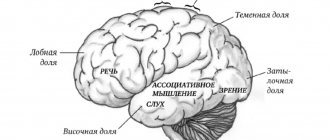What is voluntary attention, Its definition, characteristics, types, features and formation.
Attention is a special mental process through which our cognitive activity is directed and focused on phenomena and objects, processes and connections present in the world around us.
In psychology, we usually distinguish between involuntary, voluntary and post-voluntary attention based on the degree of participation of the will in the memorization process. Involuntary is not distinguished either by setting a goal to remember or by applying effort. Voluntary, on the contrary, is characterized by setting a goal to remember and the conscious use of willpower to remember. The post-voluntary grows out of the voluntary: becoming habitual, the effort of will ceases to be a burden. Goal setting remains, but volitional effort as such is no longer there. This happens when the process of purposeful effort becomes so important that a person is captured by his activity, and he no longer needs to make volitional efforts.
What is voluntary attention
The short term voluntariness of attention describes the phenomenon when an individual makes an effort to focus on something specific.
Concept and definition in psychology
Involuntary attention in psychology is a phenomenon that draws the entire being of an individual towards itself without his efforts. This definition is also called unintentional attention.
In psychology, post-voluntary attention is a “continuation” of passive voluntary attention. This is trained attention, when efforts are made, but small, i.e. the individual is able to focus on the desired object or phenomenon for a long time. This type is advantageous and effective in quickly solving everyday or unexpected problems and situations. In addition, post-voluntariness can be characterized as the most active achievement of results.
Causes of voluntary attention
How to ignore other people's opinions - is it possible to overcome fear?
Arbitrariness of attention is usually accompanied by a large or small effort of will in order to concentrate on a certain object or phenomenon. Most often, a person “spurs” himself on his own, or someone intentionally draws his attention to himself. For example, teachers in educational institutions often call out students who have apparently lost interest in what is happening. They note the behavior of young drivers who closely monitor the road, traffic, sign signals, etc., in order to prevent violations of the rules. Even visitors to shops, museums, etc. are forced to use voluntary attention so as not to miss something important, being distracted by conversations or their own thoughts while the excursion may last.
What is the reason
Arbitrariness of attention is a factor that can be determined by several parameters. Among them are the following:
- Volume. This is a person’s ability to focus on several objects or phenomena at the same time. The point is how much an individual can cover. It depends both on genetic predisposition and on physical training, life experience, etc. For statistics, it can be noted that an adult is able to simultaneously grasp 4-6 objects, and a small child - 2-3 objects.
Multitasking increases the achievement of positive results
- Concentration is the degree of concentration on an object. It is believed that concentration increases if there are few stimuli around, which will ensure high-quality assimilation of information.
- Distribution – the ability to simultaneously perform several tasks. When driving a car, a person can look at a map, talk on the phone, while keeping an eye on the road, or women, especially mothers, freely perform several functions, albeit unconsciously.
- Stability, i.e. focus of attention in the process of some activity. This is not deep concentration, but temperament, motivation in relation to the task at hand.
- Distractibility is the antonym of stability, i.e. external inhibition due to one or more stimuli.
- The fluctuation observed even at high concentrations is initially unnoticeable. This is a change in inhibition and excitability of the cerebral cortex. However, after half an hour of hard work, such fluctuations become obvious.
- Switching is the ability to move from one thing to another. A distinction is made between voluntary and involuntary switching, i.e. a person forces himself to take on another task or smoothly changes one activity to another.
Types of involuntary concentration
This type of attentiveness is influenced not only by the degree of surprise and the strength of the factors, but also by their contrast. A very familiar situation is when a speaker suddenly changes his quiet and calm speech to loud. This gesture immediately attracts and alarms the audience.
Spontaneous concentration can be divided into several types:
- Familiar. It is characterized by constant interests of the individual (in a bookstore, an artist always goes to the rack with books about fine arts).
- Involuntary. It focuses on biological needs (a hungry individual, when participating in a conversation, carefully listens to information about food).
- Forced. It manifests itself when a person is exposed to intense stimuli and repeated signals (a pedestrian turns around when he sees an ambulance or police car with a loud siren on the road).
However, not all objects can be of interest. They must first of all stand out against the background of other factors that influence the individual. Also, such an item must have distinctive features. The stronger the stimulus, the more clearly it will attract the attention of others.
Types and characteristics of voluntary attention
How to attract a girl's attention to yourself - how to interest a woman
Attention can be represented by the following types:
- Natural – associated with a person from the moment of birth, the so-called orientation reflexes, reflecting external and internal stimuli.
- Socially conditioned - develops with the course of upbringing, training, and gaining life experience. This is attention associated with selective response to objects and phenomena.
- Direct – develops on the basis of the interests and basic needs of the individual.
- Indirect - occurs thanks to special means: gestures, words, signs, etc.
Note! If a certain phenomenon or object does not arouse interest, it is difficult to focus on it. On the other hand, there are times when attention is attracted against the will of the person.
The more interesting the matter, the deeper the concentration
Features of voluntary attention
Determination - what is it in psychology
Only human beings operate with voluntary attention; its origin originates from conscious labor activity. It is noteworthy that it is formed not only from considerations of what is interesting, but also what is necessary. The main motivation for its development is a certain goal that needs to be achieved. An example is a teenager’s dream of becoming a game developer, but he will have to take many courses in programming, computerization, learn and practice mathematical formulas, which may become an uninteresting test for him.
Arbitrariness of attention has physical and psychological mechanisms, where:
- physical – occurs in the cerebral cortex in response to a signal from the outside, for example, a parent’s demand for a child to heed something;
- psychological - characterizes effort, tension of will in order to focus on an object or phenomenon, which sometimes results in fatigue, which can be more severe and longer than physical fatigue.
Note! What interferes with concentration can help it.
It is not for nothing that many people are accustomed to doing work armed with headphones playing music, or listening to the radio or news on TV, and many purposefully go to a cafe or park to work on a project or book. The point is that a person can abstract from these stimuli, turning them into so-called “white noise”. The concentration of attention increases significantly, the individual does his work, completes the task more successfully than if he were in silence. It is noteworthy that many people are literally prevented from working by their own ordinary thoughts, so they are interrupted by the notorious white noise.
Children's attentiveness
Spontaneous responses arise and persist regardless of our goals. Due to their fascination or surprise, stimuli capture and distract the individual from his activity.
Face-to-face consultation
What are the features and advantages of face-to-face consultation?
Find out more
Skype consultation
What are the features and benefits of Skype consultations?
Find out more
Babies are unable to concentrate on one specific object. They are fascinated by a variety of things - a cell phone, mom's cosmetics, dad's tools. At this age, babies are very curious. When a child grows up, he receives a lot of information and learns that on our planet there are a large number of animals of various species, insects, and plants. They begin to understand people better, distinguish hair color, eye color, skin color.
At the very beginning of life, parents help babies comprehend the world; they instill their own attitudes in the child, explain the line between good and evil, and teach them to talk. Then the baby himself begins to explore everything around him, reacting to what seems bright, unusual and unknown to him.
Children cannot regulate their own attentiveness, since they have passive concentration. Therefore, kids are attracted to various strange objects that come into their field of vision. A child may carefully look at a toy that was given to him, enjoy it, but after a minute switch to another thing. Therefore, it is easy to calm a baby down when falling or crying - you just need to distract him from the painful sensation or an unwanted object.
The ability to concentrate on one object appears in a child in the sixth year of life. I recommend praising him for any manifestation of perseverance and willpower before this age - since this is not easy for a baby. Praise will let him know that his efforts are appreciated, so he will begin to try harder to please his parents with his small victories.
If all attempts at attentive concentration are in vain, do not scold your child, ask him to try again. By reacting negatively, you will discourage your child from all the desire for knowledge, learning and perseverance.
Formation of voluntary attention
The process of training voluntary attention must begin at a young age, and this task falls on pedagogy. However, it should be noted that certain conditions contribute to good concentration:
- stable mental and physical health of the individual;
- recreating a favorable atmosphere;
- setting a specific goal;
- combination of physical and mental actions (testing theory in practice);
- alternating activities (the “pomodoro” method, when a person concentrates on work for about half an hour, then rests for 5 minutes and repeats the cycle until the work is done).
To get everything done, you need to properly distribute time and effort.
There are a number of techniques that will teach focusing, and at the same time show the current level of its development:
- You need to look at a certain picture for 5 seconds, then list the details you remember. If an individual remembers less than 5 objects, attention needs to be trained; if he named up to 9 details, the concentration is good, and more than 9 - voluntary attention is at its best.
- In front of a working TV or computer broadcasting your favorite program, movie or TV series, you need to set an alarm clock with a dial. For 2 minutes, you must closely observe the second hand, without being distracted by the TV or monitor.
- One famous way to test and train attention works on both adults and children. Take a book, newspaper or magazine. In the text (article) you need to look for something specific, for example, highlight all the letters “m” (or any other) or underline the names of people, names of cities, animals, etc.
Voluntary attention is a necessary tool in modern society, when there are so many irritants around. Statistics show that people have become more absent-minded due to the fact that they are easily distracted. This can be fixed, the main thing is to have a goal.
Properties
The peculiarities of voluntary attention are contained in a strange union of one’s own passivity and elements of the object’s activity. In other words, if a person’s voluntary attention is directed to an object he has been studying for a long time, he does not notice anything around, and the slightest change in his focus will be recorded by him. Types of voluntary attention are divided into primary, secondary and third. To return from the involuntary back to the voluntary and retain it is secondary. For example, to be distracted from the usual contemplation by an attracted foreign detail and return to the review again, trying to find the previous point of visual contact, means secondary voluntary. Suppressing the resulting absent-mindedness without effort is the third illustration.











